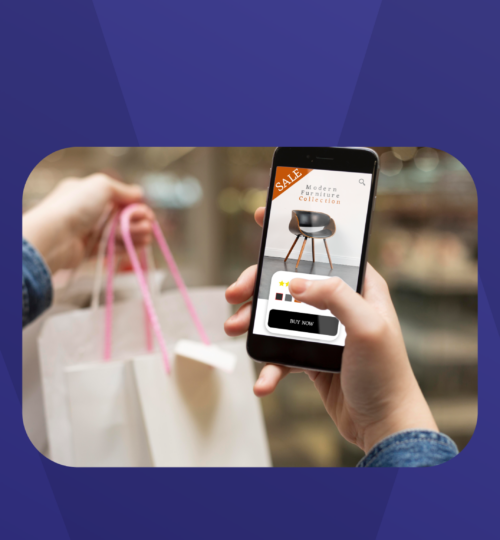Online shopping has become a significant aspect of our daily life in the modern world. Retailers are searching for fresh approaches to interact with customers and offer a seamless purchasing experience as eCommerce grows in popularity. Omnichannel eCommerce, which combines several channels, including online, mobile, and physical stores, to provide clients with a smooth purchasing experience, is one of the most promising alternatives. Retailers have paid close attention to this strategy since it enables them to engage with their clients on various levels and raises customer satisfaction.
In this article, we will explore the advantages of omnichannel eCommerce, with a particular focus on mobile commerce (mCommerce) and how it can transform the shopping experience for customers.
What is Omnichannel eCommerce and Why Should You Care?
Omnichannel eCommerce is a retail strategy that unifies and streamlines the customer experience across all of a company’s consumer touchpoints, including physical stores, websites, social media, and mobile apps. This strategy aims to provide a seamless brand experience across all channels while making it simple for customers to shop whenever and wherever they want.
Compared to multichannel eCommerce, which simply offers multiple channels for customers to shop on, omnichannel eCommerce provides a more holistic and integrated experience. Each channel may operate independently in a multichannel eCommerce approach, resulting in fragmented customer experiences and difficulties in synchronising data across channels. In contrast, omnichannel eCommerce takes a more customer-centric approach, where all channels work together to create a seamless and convenient shopping experience for customers.
Adopting an omnichannel eCommerce strategy has many advantages. It can result in better customer loyalty and retention, increased sales and revenue, decreased costs, and improved brand awareness for owners of eCommerce businesses. Businesses can strengthen relationships with their customers and raise customer satisfaction levels by offering a seamless and consistent customer experience across all channels.
By synchronising data across all channels, omnichannel eCommerce can also lower the costs associated with managing multiple channels and enhance inventory management. And at last, businesses can increase their brand awareness and reach a wider audience by developing a strong and consistent brand presence across all channels.
For online store owners aiming to give their customers a more seamless and convenient purchasing experience, omnichannel eCommerce is a strong strategy. Businesses may increase sales, brand awareness, and customer loyalty by combining all their consumer touchpoints into a coherent and comprehensive strategy. Implementing an omnichannel eCommerce strategy is becoming crucial for businesses to remain competitive in today’s market, given the rise of mobile commerce and the growing importance of convenience and accessibility in shopping.
The Importance of Mobile Commerce in Omnichannel eCommerce
Mobile commerce has revolutionised the way customers shop online. By allowing customers to shop anytime, anywhere, and on any device, mobile commerce has made the shopping experience more convenient and accessible. With the majority of consumers owning a smartphone, mobile commerce has become an integral part of the overall eCommerce experience.
Mobile shopping has improved the omnichannel eCommerce experience in addition to being convenient. Mobile commerce has made it easier to shop both online and offline by providing features like scan-and-go, smartphone payments, push alerts, and location-based services. For instance, buyers can scan a product using their mobile device in-store and put it in their online shopping basket so they can buy it later, utilising scan-and-go technology. Moreover, mobile payments give clients more flexibility by letting them use their mobile devices to make payments rather than carrying cash or credit cards.
By providing individualised recommendations and promotions based on a customer’s location and previous purchases, push notifications and location-based services have also enhanced the overall shopping experience. For instance, customers can get personalised product recommendations based on their browsing habits and preferences or alerts for deals and promotions when they are close to a physical store.
eCommerce companies may give their customers a seamless and more pleasant purchasing experience by including these aspects in their omnichannel strategy. They can boost client loyalty and boost sales by doing this. Retail mCommerce sales are anticipated to increase from 41.8% in 2022 to 43.4% of all retail eCommerce sales in 2023. Mobile commerce has made it feasible to deliver the customised and convenient buying experience that customers need. To remain competitive and exceed customer expectations, eCommerce companies must stay on top of the most recent trends and technology as mobile commerce expands and changes.
How to Offer a Mobile eCommerce App to Your Customers
In today’s mobile-first world, offering a mobile eCommerce app has become essential for any successful retail strategy. A well-designed and optimised mobile app can help retailers reach a broader audience, increase customer engagement, and boost sales. Here are some best practices for offering a mobile eCommerce app to your customers:
Make sure your app loads quickly and smoothly
Slow-loading apps can be frustrating for users and result in high abandonment rates. Therefore, it’s important to optimise your app’s code and compress images to ensure fast loading speeds.
Clear navigation and search options
Clear navigation and search options are also essential for an excellent mobile app experience. Users should be able to find what they’re looking for quickly and easily without having to navigate through multiple pages or menus. Additionally, offering personalised recommendations and reviews can help users make informed purchase decisions and improve their overall shopping experience.
High-quality images and videos
confident in their purchases. However, it’s important to optimise images and videos for mobile devices, as large files can slow down your app’s loading speed.
Now, let’s take a look at some examples of successful mobile eCommerce apps that use omnichannel eCommerce strategies to deliver exceptional customer experiences:
- Sephora Mobile App: Sephora offers a seamless omnichannel experience, allowing customers to browse products, book appointments, and redeem loyalty points across multiple channels. The app also features augmented reality technology that enables users to try on makeup virtually, making it easier for customers to find the products they love.
- Nike Mobile App: Nike offers a personalised and interactive shopping experience, featuring product recommendations based on a customer’s browsing and purchase history. The app also features a built-in chatbot that can answer customer questions and provide assistance, further enhancing the customer experience.
For any retailer aiming to boost client engagement and sales, providing a mobile eCommerce app is a requirement. Retailers can provide excellent customer experiences that foster long-term loyalty and success by adhering to best practices for app design and optimisation and putting omnichannel strategies into place.
Build a Mobile eCommerce App with No-Code
No-code app construction is a ground-breaking idea that enables people to create mobile apps without having any programming experience. For eCommerce business owners who wish to construct an eCommerce mobile app without having to employ a developer or learn how to code themselves, this technique of app creation can save time, money, and hassle.
Mowico is a no-code app builder that provides a user-friendly platform for customers to easily develop an eCommerce app. Users of Mowico may easily link their eCommerce platform, develop their app using drag-and-drop, and publish it to both the App Store and the Google Play Store.
Unlimited design elements, sophisticated push alerts, multilingual support, and integrations with well-liked eCommerce platforms and plugins are just a few of Mowico’s features and advantages. Moreover, Mowico provides augmented reality and virtual reality shopping features, which can improve customers’ buying experiences and aid in boosting conversion rates.
Ultimately, for eCommerce business owners that wish to develop a mobile eCommerce app, Mowico’s no-code mobile app building capabilities can be a game-changer. Thanks to its user-friendly platform and powerful features, Mowico makes it simple for anybody to create a professional and effective app without the need for a coding experience.
Mowico offers a free 14-day trial period if you want to check it out yourself. So why not take advantage of this chance to learn how Mowico can increase your conversion rates with a native mobile app? Start your free trial today!






